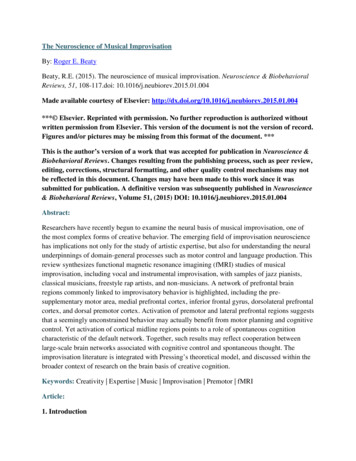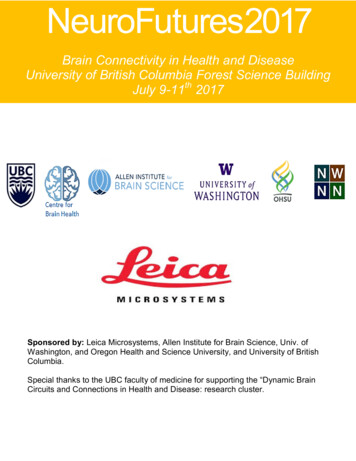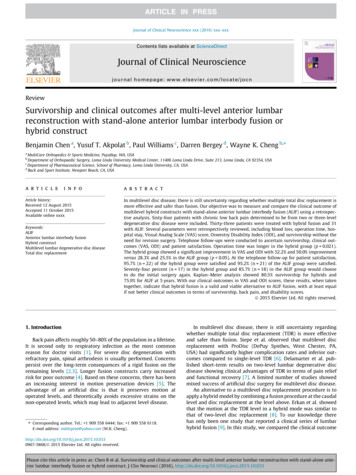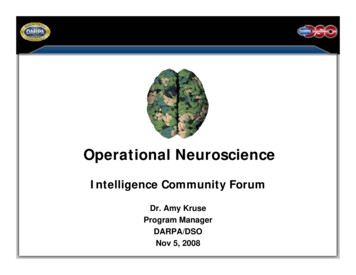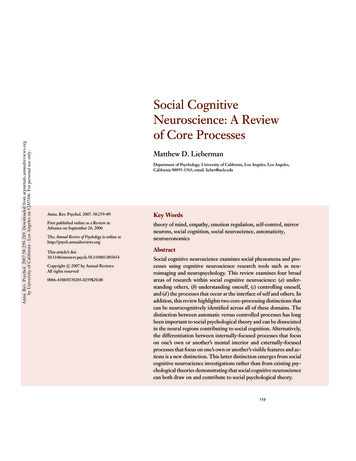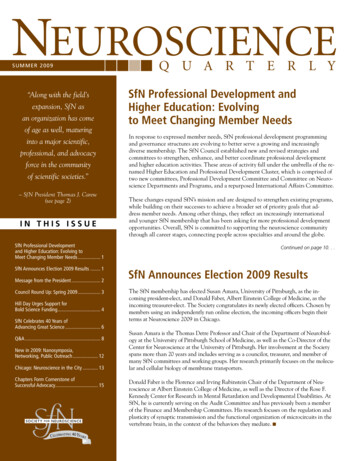
Transcription
NEUROSCIENCESU MMER 2009“Along with the field’sexpansion, SfN asan organization has comeof age as well, maturinginto a major scientific,professional, and advocacyforce in the communityof scientific societies.”— SfN President Thomas J. Carew(see page 2)In this IssueSfN Professional Developmentand Higher Education: Evolving toMeet Changing Member Needs. 1SfN Announces Election 2009 Results . 1Message from the President. 2Council Round Up: Spring 2009. 3Hill Day Urges Support forBold Science Funding. 4SfN Celebrates 40 Years ofAdvancing Great Science. 6Q&A. 8New in 2009: Nanosymposia,Networking, Public Outreach. 12Chicago: Neuroscience in the City. 13Chapters Form Cornerstone ofSuccessful Advocacy. 15CELEBRATING 40 YEARSQ U A R T E R L YSfN Professional Development andHigher Education: Evolvingto Meet Changing Member NeedsIn response to expressed member needs, SfN professional development programmingand governance structures are evolving to better serve a growing and increasinglydiverse membership. The SfN Council established new and revised strategies andcommittees to strengthen, enhance, and better coordinate professional developmentand higher education activities. These areas of activity fall under the umbrella of the renamed Higher Education and Professional Development Cluster, which is comprised oftwo new committees, Professional Development Committee and Committee on Neuroscience Departments and Programs, and a repurposed International Affairs Committee.These changes expand SfN’s mission and are designed to strengthen existing programs,while building on their successes to achieve a broader set of priority goals that address member needs. Among other things, they reflect an increasingly internationaland younger SfN membership that has been asking for more professional developmentopportunities. Overall, SfN is committed to supporting the neuroscience communitythrough all career stages, connecting people across specialties and around the globe.Continued on page 10. . .SfN Announces Election 2009 ResultsThe SfN membership has elected Susan Amara, University of Pittsburgh, as the incoming president-elect, and Donald Faber, Albert Einstein College of Medicine, as theincoming treasurer-elect. The Society congratulates its newly elected officers. Chosen bymembers using an independently run online election, the incoming officers begin theirterms at Neuroscience 2009 in Chicago.Susan Amara is the Thomas Detre Professor and Chair of the Department of Neurobiology at the University of Pittsburgh School of Medicine, as well as the Co-Director of theCenter for Neuroscience at the University of Pittsburgh. Her involvement at the Societyspans more than 20 years and includes serving as a councilor, treasurer, and member ofmany SfN committees and working groups. Her research primarily focuses on the molecular and cellular biology of membrane transporters.Donald Faber is the Florence and Irving Rubinstein Chair of the Department of Neuroscience at Albert Einstein College of Medicine, as well as the Director of the Rose F.Kennedy Center for Research in Mental Retardation and Developmental Disabilities. AtSfN, he is currently serving on the Audit Committee and has previously been a memberof the Finance and Membership Committees. His research focuses on the regulation andplasticity of synaptic transmission and the functional organization of microcircuits in thevertebrate brain, in the context of the behaviors they mediate. n
Message from the President2Coming of AgeForty years ago this month, when14 leading scientists approved andsigned the articles of incorporationof a fledgling Society for Neuroscience, they were squarely focusedon the future — giving definition,support, and energy to an emergingfield. In 2009, more than 38,000 SfNmembers worldwide still see a futureThomas J. Carew,SfN Presidentof neuroscience that remains filledwith promise. As will be evident atthis year’s SfN annual meeting in Chicago, the future ofneuroscience is constrained only by the technology we haveyet to develop and deploy, the hypotheses we have yet togenerate, the global collaborations we have yet to form, andperhaps most importantly, by the limits of our imagination.Along with the field’s expansion, SfN as an organizationhas come of age as well, maturing into a major scientific,professional, and advocacy force in the community ofscientific societies. It is striking to reflect on what we collectively have built these past 40 years. As an organization,SfN began as the scientific equivalent of a mom-and-popstore. Now, 40 years later, a little less than a mile from theWhite House, on 14th Street in Washington, DC, we areno longer that mom-and-pop store, but rather a well-oiled,lean, financially rigorous, and deeply dedicated machineworking to advance our field on a global level. A staff ofmore than 80 professionals works there each day focusedon us, the membership of SfN. They facilitate SfN’s criticalvenues for great science, like the annual meeting and TheJournal of Neuroscience. They support the neurosciencecommunity through professional development programming and growing chapter activity. And, they advocate andeducate the public tirelessly about “the universe betweenour ears.” This strong institutional backbone is a hugestructural evolution in how we do our business, and thatinfrastructure is crucial to ensure the next 40 years willadvance with the same achievement and energy.There is no SfN activity that better encapsulates the field’spotential and the diversity of SfN activities than the annual meeting, and Neuroscience 2009 will once again bea premier venue. This year it brings us to Chicago — agreat city with a history of great science and home to amagnificent conference facility that regularly hosts someof the world’s largest events. In addition, the city’s nightlife includes fantastic food and great blues and jazz. In ayear when science celebrates the anniversary of CharlesDarwin’s 100th birthday, it is fitting that in SfN’s evolutionwe are headed somewhere new and we are celebrating in acity known for magnificent natural history exhibits at theField Museum.The meeting also creates a chance to highlight 40 years ofprogress in our field and point to the future. I have triedthrough my Presidential Special Lecture series to capturethis progress with its theme “A changing brain in a changingworld.” In this series, I sought to identify ways to speak tothe field’s growth and development, echoing how the braingrows, develops, and adapts to its environment. The serieswill begin with Liz Spelke, who will discuss how cognitiondevelops, but more specifically, how the brain organizesand synthesizes abstract knowledge. Second, at the systemslevel, Richard Morris will unravel some of the mysteries ofthe brain by exploring the different but interlocking neuralmechanisms of memory. On a third level, Nora Volkowwill explore how the brain’s normal adaptive mechanismsgo awry and get hijacked by the crushing effects of addiction. Finally, Nobel Prize recipient Eric Kandel will closeby discussing the changing brain from the perspective ofthe phenomenal advances in the molecular architecture ofboth normal and abnormal memory.It is my hope that addressing the brain’s response to anever-changing world at these four levels offers an excitingway to explore the complexity of the brain while speaking to the entire SfN community — from those of us whostudy the consequences of social impact and neuroethics to those of us who examine a single synapse and themolecular universe within a single neuron. The excitingthing about our field, writ large, is that each level informsthe others. Thus, one plus one is often much more than twowhen we have all of these different levels interacting andguiding inquiry at other levels as well.The Chicago meeting also continues to capture the Society’s evolution as a key public broker for scientific discovery.Toward that end, we have added a new mechanism toengage the public: We are trying a new experiment with a“public symposium” format, which this year will focus onDarwin and evolution. This is particularly timely not onlybecause of Darwin’s anniversary, but also because the Society continues to adapt and experiment with new ways toreach the public. SfN feels a deep obligation to open doorsbetween the scientific community and the public, and thispublic symposium offers an important vehicle to addresssignificant issues in a public venue.Another aspect of the Chicago meeting that I am particularlyexcited about is this year’s Dialogues presentation — Magic,the Brain, and the Mind — which also reflects our meeting’s
evolution. The idea of the Dialogues Between Neuroscienceand Society is only five years old and thus a relatively new, buthighly successful effort to enlighten and inform us all about theconnections between our field and the larger human experience. In this year’s series, three prominent magicians, James“the Amazing” Randi, Apollo Robbins and Eric Mead, willengage in a collective dialogue with us. Each magician has hisown unique style, but there are also significant commonalities — they share a fascination with how the brain works toimplement the mental functions that underlie their craft. Eachis also a significant scholar in his discipline and truly enjoyscontact with other fields, such as neuroscience. This Dialogueis much more than “rabbit from a hat” magic. It will bringtogether different domains of a craft that has mystified us forcenturies and broaden how we think about the brain and human perception, and, at a more general level, how science andsociety intersect in diverse and stimulating ways.Another aspect of the Chicago meeting reflects how theSociety’s functions have continued to adapt and grow. Fromprofessional development to public education to press coverage, we are increasing our reach, using new tools, and looking for novel and innovative opportunities. For professionaldevelopment, our Meet-the-Experts series continues to growand expand in popularity. Our press conferences were oncetailored almost exclusively to print journalists. Today, manycredentialed outlets blog daily from the meeting and SfNmakes press conferences available to reporters remotely. Theprogram also will offer tips and tricks for engaging the publicthrough Wikipedia, and attendees will again “tweet” fromthe convention center, sharing with each other the coolestposter or the newest discovery. This year, we also have addedon-site child care as an option for scientist-parents.Finally, our changing SfN is reflected in the changingmakeup of our annual meeting attendance. Like our growing international membership, about a third of the meetingattendees come from beyond U.S. shores. The halls are brimming with younger and more diverse members, a strong andencouraging sign of our discipline’s vibrancy, and its role inblazing the trail in the next scientific frontiers. It is tremendously encouraging to look around the annual meeting hallsand know this young generation will not follow, but lead us inimaginative ways to both advance exciting new neuroscienceand to effectively communicate it. These younger membersare increasingly “professionally multilingual” — fluent infields as diverse as engineering, biology, psychology, computational science, chemistry, physics, and genetics — therebystrengthening the breadth and depth of our field.I have tried to use the Chicago meeting as a proxy for thestrength and potential of our science and our Society, capturing a sense of the bright future that continues to unfold. Atthe same time, I am keenly aware the meeting represents asingle snapshot in time that conveys a sample of the comingof age of our field. Nonetheless, as snapshots go, it’s prettycompelling, and holds great promise for an exciting meetingin an exciting city. We look forward to seeing you there! nCouncil Round-Up: Spring 2009The SfN Council, the Society’s governing body, met May26-27 in Washington, DC, for their annual spring meeting.Council addressed a number of business-related issues, whilespending a large portion of the meeting focused on Societystrategies related to professional development and international affairs. The article “SfN Professional Developmentand Higher Education: Evolving to Meet Changing MemberNeeds” provides more information on these issues (see pg. 1).The following summaries highlight other areas of discussion.Approval of the FY2010 SfN BudgetIn financially uncertain times, SfN continues to chart a strongcourse rooted in fiscally sound budgeting, an emphasis on corefunctions, and selective growth that advances key memberidentified priorities and SfN’s mission. Drawing on multi-yeardata trends, Council approved a budget that includes moderategrowth of membership, annual meeting exhibits, and subscription bases. However, Council is aware of the significanteconomic challenges confronting the scientific and academiccommunities. In that light, SfN’s leadership oversaw a strate-gic prioritizing of programmatic activities, and reviewed andapproved a conservative 3 percent increase in expenses in theFY2010 Operating Budget for the Society. This will enable SfNto continue to serve its membership in increasingly robust wayswhile being ever more efficient and effective in carrying outcore functions.Ethics Policy DiscussionThe Responsible Conduct Working Group, chaired by SfNPast President David Van Essen, presented Council with draftrevisions to the SfN Ethics Policy and Guidelines on Responsible Conduct Regarding Scientific Communication. The original policy and guidelines were developed primarily to addresswriting, reviewing, and editing of peer-reviewed manuscripts;submission of abstracts to scienti
Center for Neuroscience at the University of Pittsburgh. Her involvement at the Society spans more than 20 years and includes serving as a councilor, treasurer, and member of many SfN committees and working groups. Her research primarily focuses on the molecu - lar and cellular biology of membrane transporters. Donald Faber is the Florence and Irving Rubinstein Chair of the Department of Neu .
